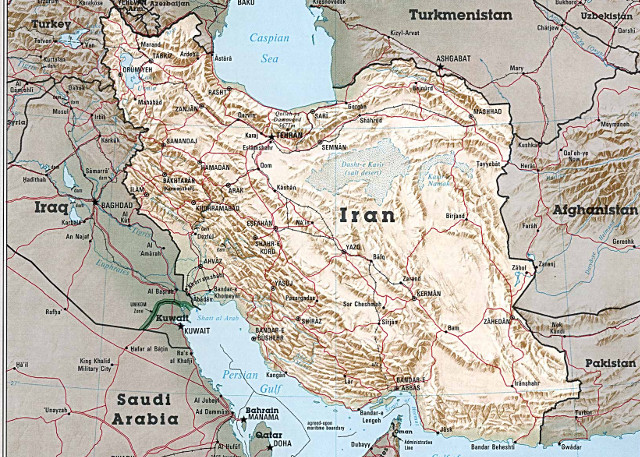by Seyed Hossein Mousavian
Pressure has once again become the name of the game in regards to U.S. policy on Iran. The Senate has passed sweeping new sanctions, and Secretary of State Rex Tillerson has declared that the U.S. will “counter Iran’s aspiration of hegemony” and work towards a “peaceful transition” of the Iranian government. As U.S.-Iran tensions increase in eastern Syria, murmurs are growing of a potential disastrous war on the horizon.
Tillerson’s call for regime change in Tehran violates international law and the 1981 Algiers Accords, which binds the U.S. to nonintervention in Iranian affairs. It also stands to put U.S.-Iran relations—which under President Obama were characterized by regular high-level diplomatic contact and the landmark nuclear deal—on the path to all-out confrontation.
In blaming Iran for sowing regional discord, the Trump administration has latched onto the self-serving narratives of Saudi and Israeli leaders, which amount to baseless scapegoating and the rewriting of contemporary history.
Iran has been a nation under siege ever since Iraqi dictator Saddam Hussein invaded the country shortly after the 1979 revolution. During the resulting eight-year war, the aggressor enjoyed support from the U.S. and other western powers as well as regional states like Saudi Arabia, which provided Saddam roughly $97 billion over the course of the war. Since that time, Iran has struggled to establish security for itself and safeguard its borders, all the while subject to draconian U.S.-led sanctions.
To its east, Iran shares a 921-kilometer border with Afghanistan, a country ravaged by war for decades. Since the 2001 U.S. invasion of Afghanistan—triggered by the 9/11 hijackers, 15 of the 19 of whom were Saudis—the country has been host to a major U.S. and NATO presence and plagued by terrorism. Nearly 16 years after the initial U.S. invasion, the Taliban control almost half the country’s territory. In addition to these security concerns, Iran has also hosted roughly three million Afghan refugees for decades and has become a major destination for Afghanistan-grown narcotics.
On its 959-kilometer border with Pakistan, a strategic U.S. and Saudi ally and a hub Saudi proselytization of its extremist Wahhabi ideology, Iran has long faced instability and attacks by Pakistan-based terrorists, such as Jundullah and Jaish al-Adl. Pakistan’s status as a nuclear-armed power wracked with domestic instability and anti-Shia violence also represents an inherent security concern to Iran.
To its west, Iran shares a 1600-kilometer border with Iraq, which has been war-torn since the 2003 U.S. invasion and a source of hundreds of thousands of refugees to Iran. In recent years, the territorial integrity of Iraq has also come under serious challenge—threating Iran and other regional states—and large parts of the country have been occupied by the Islamic State, which recently launched a brutal attack in Tehran.
Iran also shares a 534-kilometer border with Turkey, the region’s only NATO country and home to the Incirlik airbase and its U.S.-controlled nuclear weapons. In recent years, Turkey’s internal stability has come under question as the government has battled Kurds in its southeast, suffered a major uptick in terrorist attacks, and fended off a coup attempt. Increased turmoil in Turkey threatens regional security as a whole.
To its south, Iran borders the Persian Gulf and the Arab states opposite it. For decades, the Persian Gulf has been an area of massive U.S. militarization at the behest of its local autocratic allies. It’s where the U.S. houses its main regional military bases and frequently patrols Persian Gulf waters with aircraft carriers and nuclear submarines. The monarchies of the southern Persian Gulf have also been a major recipient of U.S. weapons, with Obama selling more weapons to Saudi Arabia—totaling some $115 billion—than any previous U.S. administration. President Trump, meanwhile, has already reportedly reached a $110 billion arms deal with the Saudis.
The Arab Persian Gulf powers have long toed a hardline against Iran and pushed their U.S. patron to go to war with Iran. Former U.S. Secretary of States John Kerry has recently revealed that even during the period of the nuclear negotiations—as Iran and six major world powers were working towards a diplomatic resolution of the Iranian nuclear dispute—“leaders in the region” were telling Kerry and Obama that the U.S. should “bomb these guys.”
Contrary to the Trump administration’s claim that Iran is destabilizing the region and pursuing hegemony, Iran has in fact been a victim of regional instability—which has largely been a legacy of U.S. policies—and has legitimate security threats and needs. As one Iranian military officer has said, roughly 60 percent of Iran’s border are “not controlled by the neighboring country.”
Rather than choosing to build on the nuclear deal and pursue cooperation with Iran on areas of mutual interest, such as combating terrorism, the Trump administration believes that Iran’s supposed regional activities, which Tillerson has termed “destabilizing,” are behind escalating tensions in the region.
President Trump should learn from the failure of past aggressive policies towards Iran. It should not take sides in regional rivalries by giving the Arab Persian Gulf states carte blanche to advance their narrow, sectarian agendas. Instead, Trump should acknowledge Iran as a geographical reality and foster regional cooperation by pushing U.S. regional partners to reciprocate the Iranian foreign minister’s calls for dialogue.
Ambassador Seyed Hossein Mousavian is Middle East Security and Nuclear Policy Specialist at Princeton University and a former Chief of Iran’s National Security Foreign Reactions Committee. His latest book, Iran and the United States: An Insider’s view on the Failed Past and the Road to Peace, was released in May 2014.






Bizarre to do such an exhaustive survey without mentioning Israel, which has been lobbying the US to overthrow Iran since the 1990s. Probably the #1 threat to Iranian security.
The US vastly increased instability in the Middle East with its idiotic invasion of Iraq in 2003. Many of those who so foolishly called for that invasion also promote increased hostility toward Iran.
If only Trump, Clinton, all the “Trump administration”, Obama and anyone involved, even “ordinary Americans” would read this clear, understandable and comprehensive report and take some notice, even perhaps use their brains (not the “intelligence” they claim to receive from Israel and elsewhere), we would all be better off.
Thank you for this important contribution.
Surprised, the highly aggressive policies of Israel against Iran is not touched by Sayed Hossain Mousavian. The world knows it is Israel which runs the middle eastern policies of the World sole super power.